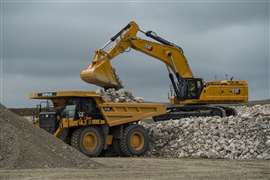6 things we learned from Caterpillar’s 2023 results
07 February 2024
 Cat’s 395 large excavator delivers more production and durability with less maintenance than the model it replaced. Photo: Caterpillar
Cat’s 395 large excavator delivers more production and durability with less maintenance than the model it replaced. Photo: Caterpillar
Earlier this week, US construction equipment manufacturer Caterpillar unveiled what it hailed as the best financial year in its history.
Sales at the company as a whole hit a record US$67.1 billion for the year, up 13% on 2022, while operating profit was $13 billion, up 64%.
Caterpillar said the increase in sales reflected higher sales volume, driven by higher sales of equipment to end users, along with its continued ability to command favourable prices for its machines. Higher sales to end users were partially offset by dealers reducing their inventories as machine availability improved – something the company had previously forecast would happen.
Here’s six things we learned about Caterpillar’s performance and how it expects to do in the year ahead:
1) Caterpillar will invest billions in new tech and supply chain resilience
The OEM has forecast capital expenditure in the range of $2 billion to $2.5 billion in 2024. That’s a higher level than in recent years and reflects heavy investment in new technology. The company’s chief financial officer Andrew Bonfield told investors that the company would spend more on autonomy, alternative fuels, connectivity and digital and electrification (AACE), as well as investing in making its supply chain more resilient. Meanwhile, the business will also invest in its large engine capacity.
2) The North American market remains surprisingly resilient
North America has continued to defy high interest and inflation rates, with Caterpillar chairman and CEO Jim Umpleby reporting that the region enjoyed a “very strong” year and that he expected it to remain healthy this year. “We expect non-residential construction to remain at similar demand levels due to government-related infrastructure investments. Residential construction is expected to remain healthy relative to historical levels,” he said.
Elsewhere, Umpleby said he expected “softening” of economic conditions in Asia Pacific, excluding China, and for China itself to remain at a low level for the above 10t excavator industry. Meanwhile, strong construction demand in the Middle East would help offset a decline in Europe amid economic uncertainty. And he forecast that sales in Latin America would increase due to easing financial conditions.
3) Dealers have reduced their inventories
Last year, as supply chain disruption started to ease and machines became more available again, Caterpillar forecast that dealers would scale back their levels of inventory in the second half of 2023. That appears to have happened, with dealer inventory of machines decreasing by $1.4 billion in the fourth quarter of the year. Umpleby told analysts, “We saw the largest decline in Construction Industries as dealer inventory decreased across all regions. The largest decline was in excavators. We remain comfortable with the total level of machine dealer inventory, which is within the typical range.”
4) Caterpillar expects a strong 2024
Looking ahead to the coming year, Bonfield told analysts that Caterpillar anticipates sales and revenue to be “broadly similar” to 2023. “We expect slightly favourable price realisation and continued healthy underlying demand across the business as a whole. We anticipate another year of services growth, as we continue to target $28 billion by 2026. We do not expect a significant change in dealer inventory for machines for the end of this year.” He also forecast that sales of equipment to end users within the Construction Industries division would be “roughly similar” to the strong year the OEM enjoyed in 2023. “We also anticipate our services initiatives to benefit the segment in 2024,” he added.
5) Supply chain constraints still exist
While the worst of the post-covid supply chain disruption has subsided, it hasn’t gone away completely, according to Umpleby. “Our internal manufacturing operations are not running as efficiently as I would like,” he told analysts. “Certainly, the supply chain constraints have started to ease and that has made things a bit easier but we are still dealing with some areas of constraint.” He said Caterpillar would work to make its processes leaner in response.
6) The energy transition and data centres should be good for business
Discussing the areas that Caterpillar is “excited about” for the future, Umpleby mentioned the opportunities presented by both the energy transition and the increasing number of data centres being built around the world. “We believe that the energy transition will increase demand for commodities over time, thereby expanding our total addressable market. As we look forward you think about the increased adoption of things like electric vehicles and the amount of minerals that will need to be produced by our mining customers to satisfy that demand.” Meanwhile, he said the growth in the construction of data centres, driven by the rise of cloud computing and generative AI, presented an opportunity for Caterpillar’s large engines, which power generators as a back-up power supply.
To read more about Caterpillar’s results, click here.
STAY CONNECTED



Receive the information you need when you need it through our world-leading magazines, newsletters and daily briefings.
CONNECT WITH THE TEAM








